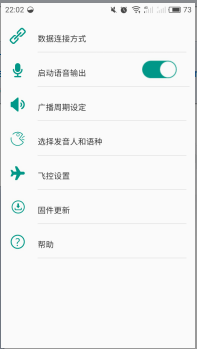我们在Android原生系统中所看到的设置界面,使用的是与Preference相关的视图完成的。使用Preference相关的视图能较好地进行了文字的分类和排版。而原生的preference基本很难满足我们的需求开发,所以自定义preference必不可缺。而为了使应用更轻量更碎片化,preferencefragment也是需要的。
本篇文章结构
将围绕一个例子进行详解,同时使用了自定义preference和preferencefragment。
1.先讲解选择开关的自定义preference(数据存储在这里细讲)
2.结合本图例子讲解preferencefragment的使用
先上图 可以看到,这是仿谷歌样式的自定义preferenc结合preferencefragment的体现。本博文将重点讲解最难的图中第二项部分。相信懂得第二项(启动语音输出)的制作,大家都会掌握自定义preference的使用啦!!此外本文也将讲解选择开关的制作(附带的!)
可以看到,这是仿谷歌样式的自定义preferenc结合preferencefragment的体现。本博文将重点讲解最难的图中第二项部分。相信懂得第二项(启动语音输出)的制作,大家都会掌握自定义preference的使用啦!!此外本文也将讲解选择开关的制作(附带的!)
1.当然是该栏的布局啦,item_preference_voice.xml
<?xml version="1.0" encoding="UTF-8"?>
<LinearLayout xmlns:android="http://schemas.android.com/apk/res/android"
android:id="@+id/widget_frame"
android:layout_width="fill_parent"
android:layout_height="wrap_content"
android:gravity="center_vertical"
android:minHeight="?android:attr/listPreferredItemHeight"
android:orientation="horizontal"
android:paddingRight="?android:attr/scrollbarSize">
<ImageView
android:id="@+id/item_preference_icon"
android:layout_width="30dp"
android:layout_height="30dp"
android:layout_gravity="center_vertical"
android:layout_marginBottom="6dp"
android:layout_marginLeft="6dip"
android:layout_marginRight="20dip" />
<LinearLayout
android:layout_width="wrap_content"
android:layout_height="50dp"
android:layout_marginLeft="2dip"
android:layout_weight="13"
android:orientation="vertical"
>
<TextView
android:id="@+android:id/title"
android:layout_width="match_parent"
android:layout_height="49dp"
android:layout_centerVertical="true"
android:ellipsize="marquee"
android:fadingEdge="horizontal"
android:gravity="center_vertical"
android:singleLine="true"
android:textAppearance="?android:attr/textAppearanceLarge"
android:textSize="15sp" />
<TextView
android:layout_width="match_parent"
android:layout_height="1px"
android:layout_gravity="bottom"
android:background="@color/gray" />
</LinearLayout>
<LinearLayout
android:layout_width="wrap_content"
android:layout_height="50dp"
android:layout_marginLeft="2dip"
android:layout_marginRight="6dip"
android:layout_weight="1"
android:orientation="vertical"
android:layout_marginEnd="0dp">
<!-- 可以看到我这里选了个自定义选择开关啦 android:button这个属性就是设置选中以及未选中的样式啦,可以自定义,关于这个下面会给出-->
<ToggleButton xmlns:android="http://schemas.android.com/apk/res/android"
android:id="@+id/mTogBtn_voice"
android:layout_width="80dp"
android:layout_height="35dp"
android:layout_marginTop="0dp"
android:background="@android:color/transparent"
android:button="@drawable/checkbox_checked_style"
android:text=" "
android:textOff=""
android:textOn="" />
<TextView
android:layout_width="match_parent"
android:layout_height="1px"
android:layout_gravity="bottom"
android:background="@color/gray"
android:layout_marginTop="14dp"/>
</LinearLayout>
</LinearLayout>
2.还有那个选择开关的样式,就是利用selector来决定选中与非选中啦
<?xml version="1.0" encoding="utf-8"?>
<selector xmlns:android="http://schemas.android.com/apk/res/android">
<item android:state_checked="true" android:drawable="@drawable/switch_on" />
<item android:drawable="@drawable/switch_off" />
</selector>
3.就是自定义preference的文件啦:
package org.fishDroneGCS.preference;
import android.content.Context;
import android.content.SharedPreferences;
import android.content.res.TypedArray;
import android.graphics.drawable.Drawable;
import android.preference.Preference;
import android.util.AttributeSet;
import android.view.LayoutInflater;
import android.view.View;
import android.view.ViewGroup;
import android.widget.ImageView;
import android.widget.ToggleButton;
import org.fishDroneGCS.android.R;
/**
* Created by 符柱成 on 2016/8/2.
*/
public class VoicePreference extends Preference {
private Drawable mIcon; //这里设置了一些属性,是为了方便保存以及设置,关于attrs中的属性一会会给出
boolean ischoose;
boolean state_ischoose;
ToggleButton toggleButton;
public VoicePreference(Context context, AttributeSet attrs) {
this(context, attrs, 0);
}
public VoicePreference(Context context, AttributeSet attrs, int defStyle) {
super(context, attrs, defStyle);
setLayoutResource(R.layout.item_preference_voice);
//从属性文件取出属性配置到我们自己设定的属性
TypedArray a = context.obtainStyledAttributes(attrs, R.styleable.SwitchBoxPreferenceScreen, defStyle, 0);
mIcon = a.getDrawable(R.styleable.SwitchBoxPreferenceScreen_preference_switchbox);
//一个选择开关的标记,记录选中与没被选中
ischoose = a.getBoolean(R.styleable.SwitchBoxPreferenceScreen_ischoose,false);
a.recycle();
}
@Override
public void onBindView(View view) {
super.onBindView(view);
ImageView imageView = (ImageView) view.findViewById(R.id.item_preference_icon);
imageView.setImageDrawable(mIcon);
//选择开关的监听
toggleButton=(ToggleButton)view.findViewById(R.id.mTogBtn_voice);
if (showSettingInfo()==true) {
toggleButton.setChecked(true);
}
else {
toggleButton.setChecked(false);
}
toggleButton.setOnClickListener(new View.OnClickListener() {
@Override
public void onClick(View v) {
if (showSettingInfo()==false) {
toggleButton.setChecked(true);
changeData(true);
}
else {
toggleButton.setChecked(false);
changeData(false);
}
}
});
}
protected View onCreateView(ViewGroup parent) {
return LayoutInflater.from(getContext()).inflate(R.layout.item_preference_voice,
parent, false);
}
//数据保存的逻辑,很简单,就是利用sharepreference来进行读取与存储
private boolean showSettingInfo() {
SharedPreferences settings = getContext().getSharedPreferences("state",Context.MODE_PRIVATE);
state_ischoose=settings.getBoolean("ischoose",false);
return state_ischoose;
}
public void changeData(boolean isUpdate) {
SharedPreferences.Editor editor = getContext().getSharedPreferences("state",Context.MODE_PRIVATE).edit();
editor.putBoolean("ischoose", isUpdate);
editor.commit();
}
}
4.自定义preference的属性:
<declare-styleable name="SwitchBoxPreferenceScreen">
<attr name="preference_switchbox" format="reference" />
<attr name="ischoose" format="boolean" />
</declare-styleable>
5.就是最后的调用啦,这个就是我的preferencefragment的布局文件啦
<?xml version="1.0" encoding="utf-8"?>
<PreferenceScreen xmlns:android="http://schemas.android.com/apk/res/android"
xmlns:coomix="http://schemas.android.com/apk/res-auto"
xmlns:preference="http://schemas.android.com/tools">
<org.fishDroneGCS.preference.PreferenceView
android:key="preference_dataConnect"
android:title="数据连接方式"
coomix:preference_icon="@drawable/link"/>
<!-- 可见这里是直接调用了我们的自定义文件啦,然后就是逻辑封装在了我们的自定义preference里,这里还需要做一步就是,设定这个选择preference的初始状态-->
<org.fishDroneGCS.preference.VoicePreference
android:key="preference_voice"
android:title="启动语音输出"
coomix:preference_switchbox="@drawable/voice"
preference:ischoose="false"/>
<org.fishDroneGCS.preference.PreferenceView
android:key="preference_broadcast"
android:title="广播周期设定"
coomix:preference_icon="@drawable/broadcast" />
<org.fishDroneGCS.preference.PreferenceView
android:key="preference_accent"
android:title="选择发音人和语种"
coomix:preference_icon="@drawable/accent" />
<org.fishDroneGCS.preference.PreferenceView
android:key="preference_plane"
android:title="飞控设置"
coomix:preference_icon="@drawable/plane" />
<org.fishDroneGCS.preference.PreferenceView
android:key="preference_firmware"
android:title="固件更新"
coomix:preference_icon="@drawable/firmware" />
<org.fishDroneGCS.preference.PreferenceView
android:key="preference_help"
android:title="帮助"
coomix:preference_icon="@drawable/help" />
</PreferenceScreen>
6.然后给出最终的在preferencefragment的调用:
如果您是开发针对 Android 3.0(API 级别 11)及更高版本系统的应用,则应使用 PreferenceFragment 显示 Preference 对象的列表。您可以将 PreferenceFragment 添加到任何 Activity,而不必使用 PreferenceActivity。
无论您在构建何种 Activity,片段都可为应用提供一个更加灵活的体系结构。 因此,我们建议您尽可能使用 PreferenceFragment 控制设置的显示,而不是使用 PreferenceActivity。
PreferenceFragment 的实现就像定义 onCreate() 方法以使用 addPreferencesFromResource() 加载首选项文件一样简单。
public class SettingFragment extends PreferenceFragment {
//那个自定义的PreferenceView一会再给出
private PreferenceView connect;
private VoicePreference voice;
private PreferenceView broadcast;
private PreferenceView accent;
private PreferenceView planeSetting;
private PreferenceView firmware;
private PreferenceView help;
@Override
public View onCreateView(LayoutInflater inflater, ViewGroup container, Bundle savedInstanceState) {
//注意为什么要先套一个布局呢?因为有没有注意到一开始的图片呢,每个preference的分隔线,为什么只在内容那里才有呢?因为如果不先加这个布局,那么分隔线是布满一整行的。所以这就是谷歌的设计风格啦!!拉拉啦!布局一会给出
View view = inflater.inflate(R.layout.preference_list, null);
addPreferencesFromResource(R.xml.preference);
initPreferences(getPreferenceManager());
initListener();
return view;
}
//很简单就是初始化啦
private void initPreferences(PreferenceManager manager) {
connect = (PreferenceView) manager.findPreference("preference_dataConnect");
voice = (VoicePreference) manager.findPreference("preference_voice");
broadcast = (PreferenceView) manager.findPreference("preference_broadcast");
accent = (PreferenceView) manager.findPreference("preference_accent");
planeSetting = (PreferenceView) manager.findPreference("preference_plane");
firmware = (PreferenceView) manager.findPreference("preference_firmware");
help = (PreferenceView) manager.findPreference("preference_help");
}
//附送写好了的监听,哈哈
private void initListener() {
connect.setOnPreferenceClickListener(new Preference.OnPreferenceClickListener() {
@Override
public boolean onPreferenceClick(Preference preference) {
//刚刚没有给出activity调用preferencefragment就在这里给出啦!!很简单的一句话。
getFragmentManager().beginTransaction().replace(android.R.id.content, new LinkFragment()).commit();
return false;
}
});
broadcast.setOnPreferenceClickListener(new Preference.OnPreferenceClickListener() {
@Override
public boolean onPreferenceClick(Preference preference) {
return false;
}
});
accent.setOnPreferenceClickListener(new Preference.OnPreferenceClickListener() {
@Override
public boolean onPreferenceClick(Preference preference) {
return false;
}
});
planeSetting.setOnPreferenceClickListener(new Preference.OnPreferenceClickListener() {
@Override
public boolean onPreferenceClick(Preference preference) {
return false;
}
});
firmware.setOnPreferenceClickListener(new Preference.OnPreferenceClickListener() {
@Override
public boolean onPreferenceClick(Preference preference) {
return false;
}
});
help.setOnPreferenceClickListener(new Preference.OnPreferenceClickListener() {
@Override
public boolean onPreferenceClick(Preference preference) {
return false;
}
});
}
}
7.preference_list.xml
<?xml version="1.0" encoding="utf-8"?>
<LinearLayout xmlns:android="http://schemas.android.com/apk/res/android"
android:layout_width="fill_parent"
android:layout_height="fill_parent"
android:orientation="vertical">
<!-- 注意id喔,是系统id的格式,哈哈哈-->
<ListView
android:id="@android:id/list"
android:layout_width="fill_parent"
android:layout_height="wrap_content"
android:layout_marginLeft="10dp"
android:layout_marginTop="10dp"
android:cacheColorHint="#00000000"
android:divider="@color/white" />
</LinearLayout>
### 8.补充刚刚遗漏的自定义PreferenceView
<!-- 布局-->
<?xml version="1.0" encoding="UTF-8"?>
<LinearLayout xmlns:android="http://schemas.android.com/apk/res/android"
android:id="@+id/widget_frame"
android:layout_width="fill_parent"
android:layout_height="wrap_content"
android:gravity="center_vertical"
android:minHeight="?android:attr/listPreferredItemHeight"
android:orientation="horizontal"
android:paddingRight="?android:attr/scrollbarSize">
<ImageView
android:id="@+id/item_preference_icon"
android:layout_width="30dp"
android:layout_height="30dp"
android:layout_gravity="center_vertical"
android:layout_marginBottom="6dp"
android:layout_marginLeft="6dip"
android:layout_marginRight="20dip" />
<LinearLayout
android:layout_width="wrap_content"
android:layout_height="50dp"
android:layout_marginLeft="2dip"
android:layout_marginRight="6dip"
android:layout_weight="1"
android:orientation="vertical">
<TextView
android:id="@+android:id/title"
android:layout_width="match_parent"
android:layout_height="49dp"
android:layout_centerVertical="true"
android:ellipsize="marquee"
android:fadingEdge="horizontal"
android:gravity="center_vertical"
android:singleLine="true"
android:textAppearance="?android:attr/textAppearanceLarge"
android:textSize="15sp" />
<TextView
android:layout_width="match_parent"
android:layout_height="1px"
android:layout_gravity="bottom"
android:background="@color/gray" />
</LinearLayout>
</LinearLayout>
//大体跟我上面举例的那个自定义preference差不多
public class PreferenceView extends Preference {
private static final String TAG = "IconPreferenceScreen";
private Drawable mIcon;
public PreferenceView(Context context, AttributeSet attrs) {
this(context, attrs, 0);
}
public PreferenceView(Context context, AttributeSet attrs, int defStyle) {
super(context, attrs, defStyle);
setLayoutResource(R.layout.item_preference_view);
TypedArray a = context.obtainStyledAttributes(attrs, R.styleable.PreferenceScreen, defStyle, 0);
mIcon = a.getDrawable(R.styleable.PreferenceScreen_preference_icon);
}
@Override
public void onBindView(View view) {
super.onBindView(view);
ImageView imageView = (ImageView) view.findViewById(R.id.item_preference_icon);
if (imageView != null && mIcon != null) {
imageView.setImageDrawable(mIcon);
}
}
}
好啦,到此就讲完自定义preference和PreferenceFragment的使用啦。最后给出一篇基本应用preference的文章,还没学过用preference的同学可以看下。基本的preference应用
欢迎指出错误,共同学习!啦啦啦啦!
转载请注明:【JackFrost的博客】





















 1688
1688











 被折叠的 条评论
为什么被折叠?
被折叠的 条评论
为什么被折叠?








